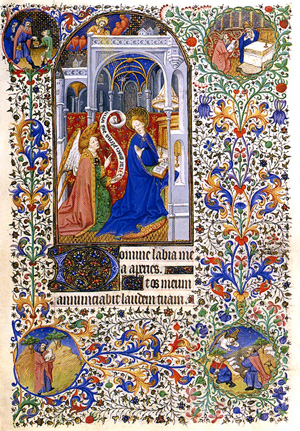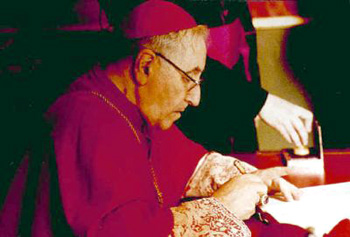 |
A Column of Catholic Orientation
Latin: An Indispensable Factor of Unity
Marian T. Horvat, Ph.D.
Jan sent me this question: Why should Latin be the language of the Catholic liturgy?

Above, a book of prayers in Latin |
Let me establish some presuppositions to avoid confusion. The universal rite of the Catholic Church is the Latin rite. This means that all the religious ceremonies up until Vatican II – the Mass, Sacraments, Psalms, official hymns, etc – were said in Latin. Latin had, in fact, every qualification to be the international language of communication inside the Church. In Roman times, it had united a vast group of peoples; adopted by the early Church it became the symbol of unity between the Catholic peoples of Europe. It was not the particular privilege of any nation. It had other qualities of universality, an unchanging character that safeguarded the purity of doctrine of the Church as well as a majestic form suitable for devotion and worship.
For different historic reasons, the Church has various other rites for certain groups of people. The Maronite and Melchite rites say their Masses in Greek, others like the Chaldean, Copt, Ukrainian, and Russian use their respective languages. They are beautiful exceptions to the principal rule: the universal rite of the Catholic Church is the Latin rite. As with all exceptions, they confirm the rule instead of weaken it.
From Vatican II on, the Latin was virtually abolished from the Latin rite – a curious paradox, isn’t it? It was replaced by the vernacular – the local language - in the Mass and most of the other liturgical ceremonies. There have been many dire consequences to this ill-considered measure. Here let me examine one, the damage to an important and enduring mark of the Church – her unity.
Shopping for the perfect Mass
I have at hand the article, “Shopping for the perfect Mass,” written by Msgr. Owen Campion addressing this topic of unity. (1) He complained that in a certain large metropolitan center, people from 30 surrounding counties were coming to Mass at an old parish church because the priest celebrates a “conservative” Novus Ordo Mass with solemn, sacral music. Some were driving many miles to assist there, passing by their local parishes without a second thought. This was most disturbing to Msgr. Campion. For generations, he pointed out, Catholics in this country always attended Mass in their geographic parish.
This is quite true. I remember three fine Polish ladies in Kansas City who had a great misfortune of living several blocks outside the limits the Diocese set for the Polish parish of St. Benedict's. And so they dutifully, although regretfully, were members of the German parish of St. Anthony's, whose geographic boundaries they fell within. After all, the Mass was the same everywhere.
Whether the parish was Polish or German or French, whether you were in the United States, Italy, or Africa, a Catholic found the same Latin Liturgy. From pole to pole, no Catholic was a foreigner anywhere because he could enter a Catholic Church and hear the same ceremonies in the same language and mingle his voice with those of his brothers. The use of Latin in all countries that followed the Latin rite across the centuries was a bond of unity in the Church.
Pope Pius XI stated this clearly in 1922 in Officiorum omnium:
“Precisely because she embraces all nations and is destined to endure until the end of time, the Church … by her very nature requires a language that is universal, immutable, and non-vernacular.”
That language was Latin, which formed a bond of immense strength uniting the parish from the furthest environs of Asia or mountain village of Peru to the Church’s universal center in Rome.
The vernacular leads to a Babel of confusion

The use of vernacular brought other novelties. Above, a polka band performs at Mass. Below, a priest says Mass for youth sitting on the grass.
 |
Then, some 40 years ago, a change occurred. One of the first concrete changes the everyday man experienced caused by Vatican II was an alteration in the Liturgy. The vernacular was introduced into the New Order Mass. In the United States, at first English was used everywhere in the Mass but the Canon; after several years, the Canon was also in English. In the other liturgical ceremonies and offices as well, Latin, the language of the Church, just disappeared.
Suddenly – in retrospect today, it seems almost overnight – the Mass no longer seemed to be the same. Different Canons appeared, followed by different prayers, different music, different styles and expression. Launched as pluralistic and experimental, the new liturgical orientation lent itself to all kinds of novelties. Now at St. Anthony’s you could find a polka Mass. If you wanted something more in step with the times, there was a guitar Mass at Holy Name Church that played to rock ‘n’ roll rhythm. If you didn’t like the changes, you could go to St. Patrick’s where the Kyrie and Sanctus were still sung – the priest was conservative there. The unity of the Catholic worship was gone. And so, as time passed, persons began to “shop” for a Mass to suit their tastes, just as the Protestants do.
This wasn’t supposed to happen, we are told by the conservative Catholics who are always trying to find a way to salvage Vatican Council II. The Constitution on the Sacred Liturgy actually says that "the use of Latin is to be preserved in the Latin rites" (Sacrosanctum Concilium, 54). In the Liturgical Reform that started even during the Council, this text was ignored. Instead, what was applied everywhere was the part of the same document that instructed “adapting the rites of the Sacraments and sacramentals to present-day needs.” (SC 62). Also it was alleged that the vernacular was necessary so that people could “understand the texts and rites with ease” and “take part in them fully, actively and as a community” (SC 21b) .
At the Council, then-Father Joseph Ratzinger, an enthusiastic advocate for the "reform," predicted the resulting variety in liturgies of various cultures and insisted it would enrich the Church. He argued:
“This decision [for multiple liturgies in vernacular] makes it possible to restore to liturgy that Catholicity which the Church Fathers saw symbolized in Psalm 44 – the bride with her many-colored raiment. We may restore to the liturgy all the fullness which is quickening the Church.” (2)
But instead of a poetic variety, what the Council produced was another Tower of Babel, a new confusion of languages, as well as the slaughter of the single uniform Roman liturgy.
Amid this general confusion, there were yet more problems ahead for the English-speaking peoples. On October 17, 1963 the International Commission on English in the Liturgy (ICEL) was established with the aim of providing uniformity in the use of English in the Mass and liturgy. Instead of uniformity, the outcome was more dissension and confusion.
Anyone who has followed the torturous history of ICEL translations recognizes the imprecision and ambiguities in their constantly changing interpretations. This is what happens: The ICEL presents a translation, the revisions begin, followed by new revisions. It has become an unending process. Forty years after it was founded, the ICEL has still not produced a satisfactory English translation of the Mass.
When the ICEL finally agrees on a new translation, the text must muster approval with the Bishops. In November 2005, the last meeting of the US Conference of Catholic Bishops (USSCB), a review began on the second draft translation of the Mass from the 2002 Roman Missal. Immediately two sides formed, one group of Prelates demanding more liberal terminology, another insisting on more conservative vocabulary. (3) It is estimated the new approved version will be released in 2007 - should the impasse be crossed. In summation, what has resulted is one liturgical confusion on top of another.
The warning of Cardinal Siri
This confusion and instability in liturgy we are experiencing today was predicted by Cardinal Giuseppe Siri in 1958, the year John XXIII assumed the throne of Peter. In a Pastoral Letter to the Clergy of Genoa, he warned that in certain quarters where, in the name of modernity, the vernacular was already replacing Latin, one could observe that everything had crumbled. The services were gone, the adornments in worship were gone, The Lord’s Day was not observed; insanities abounded in art and architecture; and the language was “mostly babble of completely vague and general statements.” (4) Don’t let this happen to the Catholic Church, he warned.

On the eve of the Council Cardinal Siri issued a strong warning not to adopt the vernacular in Catholic liturgy |
He continued in a strong tone, insisting that taking the road to the vernacular was to protestantize the liturgy:
“We are convinced that the mania for spoliation is a disease that is recurrent, which must be resisted as all maladies are resisted, and that we must avoid representing it as a new virtue. This path of spoliation is the path to Protestantism.” (5)
In practice, Cardinal Siri noted, the Church would not only have to modify its language, but also write new texts continuously to keep with current attitudes. It would be the start of the endless cycle of revisions, which in fact we are experiencing today:
“Truly, adoption of a spoken language throughout the Liturgy would entail the burden not merely of an accurate translation made once and for all, but also of refining it and endlessly brining it up to date. Spoken languages change tastes often; they also change in partialities for a style, for meaning of idioms, and for words themselves. … Change in style, in phraseology, in vocabulary, in meaning would cause serious drawbacks. The Church cannot set about acting as a permanent school of linguistic updating. She has other things to do.” (6)
He concludes that the Latin liturgy is the bond associating Catholic peoples; therefore, the need for a single liturgical language which strengthens fraternity between Catholic peoples and maintains the idea of a single center:
“The greatest uniting factor, immediate and directly operative among men, has at all times been language … Hence it follows, so we believe without fear of contradiction, that the great human means for the Church’s unity is the use of a common language. The common language is Latin.” (7)

A consequence of the Liturgical Reform:
In India a Hindu-style for Catholics - Catholic Far East, July-August 2000 |
Doing away with Latin in liturgy has had a baleful consequence. The various spoken languages introduced in the liturgy had led to conglomerates of national churches. Today we find an American Church, German Church, African Church, Asian Church, and so on. Each one strives to highlight particular characteristics of its native art, music and cultural practices in its liturgy that remove it further from the center of unity.
Abandoning fidelity to tradition in the liturgy has not resulted in a more vibrant, rich liturgy. Quite the opposite. We have a trivial and common language in a constant state of change, imparting a tone of instability to the Faith of all ages. And there is a disturbing lack of uniformity.
Today, therefore, there is a variety of Masses a Roman Catholic can seek out: the traditionalist Masses, the Novus Ordo Masses being said in Latin here and there, and of course, the astonishing variety of New Order Masses found in every diocese.
The unity of Catholic worship has been swept away.
1. Our Sunday Visitor, April 4, 2004.
2. John J. Allen, “Past is prologue to liturgy debate,” National Catholic Reporter, April 28, 2000
3. Helen Hull Hitchcock, “USCCB November Meeting”, Adoremus Bulletin, Vol. XI, No. 9
4. “The Latin Language and the Italian Language in the Liturgy,” Pastoral Letter to the clergy of the Diocese of Genoa, Italy, of August 19, 1958, in Inside the Vatican, March/April, 2004, pp. 45-60.
5. Ibid.
6. Ibid.
7. Ibid.

Posted on March 2, 2006

Related Topics of Interest
 Hindu Dances During John Paul II's Mass in New Delhi Hindu Dances During John Paul II's Mass in New Delhi
 The True Colors of Benedict XVI The True Colors of Benedict XVI
 Liberals, Modernists and Progressivists Liberals, Modernists and Progressivists
 The Canonization of Wojtyla, the Moral-Free Pope The Canonization of Wojtyla, the Moral-Free Pope
 Liturgical Dancing over the Altar in the Cleveland Diocese Liturgical Dancing over the Altar in the Cleveland Diocese
 Traditionalist Issues Traditionalist Issues
 Crisis in Ecumenism Crisis in Ecumenism
 The Bad Effects of Papal Apologies The Bad Effects of Papal Apologies

|
Related Works of Interest
|
Talks with Jan | Religious | Home | Books | CDs | Search | Contact Us | Donate

© 2002-
Tradition in Action, Inc. All Rights Reserved
|
 |
|